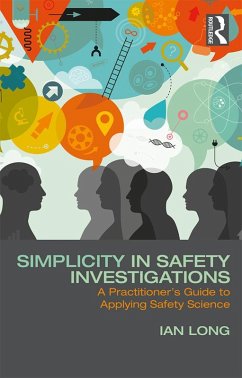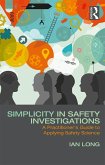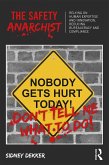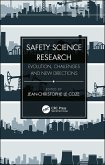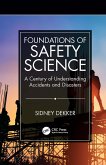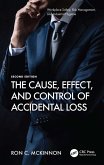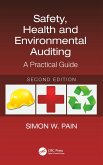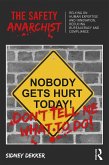Ian Long
Simplicity in Safety Investigations (eBook, ePUB)
A Practitioner's Guide to Applying Safety Science
40,95 €
40,95 €
inkl. MwSt.
Sofort per Download lieferbar

20 °P sammeln
40,95 €
Als Download kaufen

40,95 €
inkl. MwSt.
Sofort per Download lieferbar

20 °P sammeln
Jetzt verschenken
Alle Infos zum eBook verschenken
40,95 €
inkl. MwSt.
Sofort per Download lieferbar
Alle Infos zum eBook verschenken

20 °P sammeln
Ian Long
Simplicity in Safety Investigations (eBook, ePUB)
A Practitioner's Guide to Applying Safety Science
- Format: ePub
- Merkliste
- Auf die Merkliste
- Bewerten Bewerten
- Teilen
- Produkt teilen
- Produkterinnerung
- Produkterinnerung

Bitte loggen Sie sich zunächst in Ihr Kundenkonto ein oder registrieren Sie sich bei
bücher.de, um das eBook-Abo tolino select nutzen zu können.
Hier können Sie sich einloggen
Hier können Sie sich einloggen
Sie sind bereits eingeloggt. Klicken Sie auf 2. tolino select Abo, um fortzufahren.

Bitte loggen Sie sich zunächst in Ihr Kundenkonto ein oder registrieren Sie sich bei bücher.de, um das eBook-Abo tolino select nutzen zu können.
This innovative book aims to bring the science of safety into a simple and practical approach to investigating workplace incidents, using the ideas of some of the great safety science thinkers of our time. This book serves as an easy-to-follow, real-world reference for supervisors, managers and safety practitioners across many industries.
- Geräte: eReader
- mit Kopierschutz
- eBook Hilfe
- Größe: 0.68MB
Andere Kunden interessierten sich auch für
![Simplicity in Safety Investigations (eBook, PDF) Simplicity in Safety Investigations (eBook, PDF)]() Ian LongSimplicity in Safety Investigations (eBook, PDF)40,95 €
Ian LongSimplicity in Safety Investigations (eBook, PDF)40,95 €![The Safety Anarchist (eBook, ePUB) The Safety Anarchist (eBook, ePUB)]() Sidney DekkerThe Safety Anarchist (eBook, ePUB)35,95 €
Sidney DekkerThe Safety Anarchist (eBook, ePUB)35,95 €![Safety Science Research (eBook, ePUB) Safety Science Research (eBook, ePUB)]() Safety Science Research (eBook, ePUB)48,95 €
Safety Science Research (eBook, ePUB)48,95 €![Foundations of Safety Science (eBook, ePUB) Foundations of Safety Science (eBook, ePUB)]() Sidney DekkerFoundations of Safety Science (eBook, ePUB)52,95 €
Sidney DekkerFoundations of Safety Science (eBook, ePUB)52,95 €![The Cause, Effect, and Control of Accidental Loss (eBook, ePUB) The Cause, Effect, and Control of Accidental Loss (eBook, ePUB)]() Ron C. McKinnonThe Cause, Effect, and Control of Accidental Loss (eBook, ePUB)46,95 €
Ron C. McKinnonThe Cause, Effect, and Control of Accidental Loss (eBook, ePUB)46,95 €![Safety, Health and Environmental Auditing (eBook, ePUB) Safety, Health and Environmental Auditing (eBook, ePUB)]() Simon Watson PainSafety, Health and Environmental Auditing (eBook, ePUB)50,95 €
Simon Watson PainSafety, Health and Environmental Auditing (eBook, ePUB)50,95 €![The Safety Anarchist (eBook, PDF) The Safety Anarchist (eBook, PDF)]() Sidney DekkerThe Safety Anarchist (eBook, PDF)35,95 €
Sidney DekkerThe Safety Anarchist (eBook, PDF)35,95 €-
-
-
This innovative book aims to bring the science of safety into a simple and practical approach to investigating workplace incidents, using the ideas of some of the great safety science thinkers of our time. This book serves as an easy-to-follow, real-world reference for supervisors, managers and safety practitioners across many industries.
Hinweis: Dieser Artikel kann nur an eine deutsche Lieferadresse ausgeliefert werden.
Dieser Download kann aus rechtlichen Gründen nur mit Rechnungsadresse in A, B, BG, CY, CZ, D, DK, EW, E, FIN, F, GR, HR, H, IRL, I, LT, L, LR, M, NL, PL, P, R, S, SLO, SK ausgeliefert werden.
Hinweis: Dieser Artikel kann nur an eine deutsche Lieferadresse ausgeliefert werden.
Produktdetails
- Produktdetails
- Verlag: Taylor & Francis eBooks
- Seitenzahl: 152
- Erscheinungstermin: 31. August 2017
- Englisch
- ISBN-13: 9781351598989
- Artikelnr.: 49258490
- Verlag: Taylor & Francis eBooks
- Seitenzahl: 152
- Erscheinungstermin: 31. August 2017
- Englisch
- ISBN-13: 9781351598989
- Artikelnr.: 49258490
- Herstellerkennzeichnung Die Herstellerinformationen sind derzeit nicht verfügbar.
Ian Long has worked for over twenty years in Health and Safety roles in the minerals extraction and processing industry. As the managing director of his own consultancy business, he now provides in-the-field coaching and coach-the-coach activities with leaders, along with training and facilitation of fatality and other significant incident investigations.
Acknowledgments
Preface
What level of investigation should we do?
Using this book and the techniques described within it for positive
investigations
Some essentials
1 Mindset and approach
2 Before you investigate
Team formation, structure and roles
The art of facilitation and using a coaching style
Your conversations and questions (before and after an event)
3 The investigation process
Scene preservation.
Interviewing (versus taking statements)
Generous listening
The interview conversation
Data and information gathering
How to run an effective and efficient PEEPO
Determining Work-As-Done, Work-As-Normal and Work-As-Intended
Determining Work-As-Done, Work-As-Normal and Work-As-Intended in the case
of more detailed incident investigations
Exploration of the gaps between Work-As-Done, Work-As-Normal and
Work-As-Intended
Build the story (Incident Pathway Statement)
SMARTS actions
Reports
4 The technical and scientific stuff
Task complexity, procedural complexity and adequacy, and situational
complexity
Resilience and resilience engineering
Risk intelligence, risk identification and risk management
Drift (procedural or practical drift)
Internal decision and sense-making
Intense task focus
Answering a different question
What-You-See-Is-All-There-Is (WYSIATI) and plan continuation
Shared Space as it relates To safe work spaces
Effective 'core competency training' and 'awareness induction'
Individual actions and assessments
Systems of work and their interrelationships
It is all obvious when you know the outcome (hindsight bias)
Accountability and authority mismatch
Equipment, tools and plant design
Task planning, assignment, acceptance and monitoring
Leadership
Other cognitive biases and heuristics
The efficiency - thoroughness trade-off (ETTO)
5 Conclusion
Appendices:
A. Interviewing - Having meaningful conversations
B. Incident Cause Analysis Method (ICAM) process
Bibliography and reading list.
Index
Preface
What level of investigation should we do?
Using this book and the techniques described within it for positive
investigations
Some essentials
1 Mindset and approach
2 Before you investigate
Team formation, structure and roles
The art of facilitation and using a coaching style
Your conversations and questions (before and after an event)
3 The investigation process
Scene preservation.
Interviewing (versus taking statements)
Generous listening
The interview conversation
Data and information gathering
How to run an effective and efficient PEEPO
Determining Work-As-Done, Work-As-Normal and Work-As-Intended
Determining Work-As-Done, Work-As-Normal and Work-As-Intended in the case
of more detailed incident investigations
Exploration of the gaps between Work-As-Done, Work-As-Normal and
Work-As-Intended
Build the story (Incident Pathway Statement)
SMARTS actions
Reports
4 The technical and scientific stuff
Task complexity, procedural complexity and adequacy, and situational
complexity
Resilience and resilience engineering
Risk intelligence, risk identification and risk management
Drift (procedural or practical drift)
Internal decision and sense-making
Intense task focus
Answering a different question
What-You-See-Is-All-There-Is (WYSIATI) and plan continuation
Shared Space as it relates To safe work spaces
Effective 'core competency training' and 'awareness induction'
Individual actions and assessments
Systems of work and their interrelationships
It is all obvious when you know the outcome (hindsight bias)
Accountability and authority mismatch
Equipment, tools and plant design
Task planning, assignment, acceptance and monitoring
Leadership
Other cognitive biases and heuristics
The efficiency - thoroughness trade-off (ETTO)
5 Conclusion
Appendices:
A. Interviewing - Having meaningful conversations
B. Incident Cause Analysis Method (ICAM) process
Bibliography and reading list.
Index
Acknowledgments
Preface
What level of investigation should we do?
Using this book and the techniques described within it for positive
investigations
Some essentials
1 Mindset and approach
2 Before you investigate
Team formation, structure and roles
The art of facilitation and using a coaching style
Your conversations and questions (before and after an event)
3 The investigation process
Scene preservation.
Interviewing (versus taking statements)
Generous listening
The interview conversation
Data and information gathering
How to run an effective and efficient PEEPO
Determining Work-As-Done, Work-As-Normal and Work-As-Intended
Determining Work-As-Done, Work-As-Normal and Work-As-Intended in the case
of more detailed incident investigations
Exploration of the gaps between Work-As-Done, Work-As-Normal and
Work-As-Intended
Build the story (Incident Pathway Statement)
SMARTS actions
Reports
4 The technical and scientific stuff
Task complexity, procedural complexity and adequacy, and situational
complexity
Resilience and resilience engineering
Risk intelligence, risk identification and risk management
Drift (procedural or practical drift)
Internal decision and sense-making
Intense task focus
Answering a different question
What-You-See-Is-All-There-Is (WYSIATI) and plan continuation
Shared Space as it relates To safe work spaces
Effective 'core competency training' and 'awareness induction'
Individual actions and assessments
Systems of work and their interrelationships
It is all obvious when you know the outcome (hindsight bias)
Accountability and authority mismatch
Equipment, tools and plant design
Task planning, assignment, acceptance and monitoring
Leadership
Other cognitive biases and heuristics
The efficiency - thoroughness trade-off (ETTO)
5 Conclusion
Appendices:
A. Interviewing - Having meaningful conversations
B. Incident Cause Analysis Method (ICAM) process
Bibliography and reading list.
Index
Preface
What level of investigation should we do?
Using this book and the techniques described within it for positive
investigations
Some essentials
1 Mindset and approach
2 Before you investigate
Team formation, structure and roles
The art of facilitation and using a coaching style
Your conversations and questions (before and after an event)
3 The investigation process
Scene preservation.
Interviewing (versus taking statements)
Generous listening
The interview conversation
Data and information gathering
How to run an effective and efficient PEEPO
Determining Work-As-Done, Work-As-Normal and Work-As-Intended
Determining Work-As-Done, Work-As-Normal and Work-As-Intended in the case
of more detailed incident investigations
Exploration of the gaps between Work-As-Done, Work-As-Normal and
Work-As-Intended
Build the story (Incident Pathway Statement)
SMARTS actions
Reports
4 The technical and scientific stuff
Task complexity, procedural complexity and adequacy, and situational
complexity
Resilience and resilience engineering
Risk intelligence, risk identification and risk management
Drift (procedural or practical drift)
Internal decision and sense-making
Intense task focus
Answering a different question
What-You-See-Is-All-There-Is (WYSIATI) and plan continuation
Shared Space as it relates To safe work spaces
Effective 'core competency training' and 'awareness induction'
Individual actions and assessments
Systems of work and their interrelationships
It is all obvious when you know the outcome (hindsight bias)
Accountability and authority mismatch
Equipment, tools and plant design
Task planning, assignment, acceptance and monitoring
Leadership
Other cognitive biases and heuristics
The efficiency - thoroughness trade-off (ETTO)
5 Conclusion
Appendices:
A. Interviewing - Having meaningful conversations
B. Incident Cause Analysis Method (ICAM) process
Bibliography and reading list.
Index
